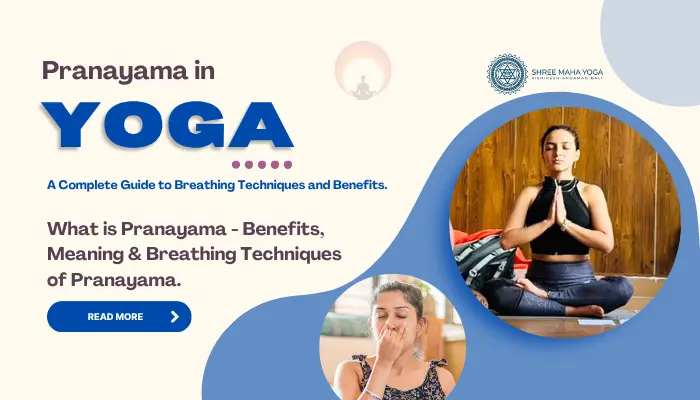Introduction : Pranayama in Yoga - A Complete Guide to Breathing Techniques and Benefits
Pranayama is a foundational element of traditional yoga that goes beyond physical movement and dives deep into the art of breath control. If you're searching for answers to what is pranayama or want to explore its powerful effects on the body and mind, this blog offers everything you need to know.
We’ll explain the Pranayama Meaning, explore various Pranayama Breathing Techniques, and show how Pranayama Yoga can improve your overall health and well-being.
What is Pranayama?
In Sanskrit, ‘Prana’ refers to the life force or vital energy, and ‘Ayama’ means Expansion or Control. So, Pranayama simply means the practice of controlling and expanding one’s life energy through breath.
In yogic philosophy, breath is seen as a bridge between the mind and body. Practicing Pranayama Breathing helps regulate the nervous system, balance emotions, and prepare the mind for deeper meditation.
Why is Pranayama Important in Yoga?
While Yoga is often associated with physical postures, Pranayama Yoga plays an equally essential role. Breath control is considered one of the eight limbs of yoga (Ashtanga Yoga) as described by "Patanjali in the Yoga Sutras".
The Benefits of Pranayama go beyond physical health — it also enhances emotional balance, sharpens mental focus, and nurtures spiritual growth. It serves as a powerful tool to connect breath, body, and awareness.
Top Benefits of Pranayama Breathing :-
Regular practice of pranayama breathing techniques can bring positive changes to your health and lifestyle:
- 🌬️ Improves respiratory strength and lung capacity.
- 🧠 Enhances mental clarity and concentration.
- 😌 Reduces anxiety and emotional stress.
- 🛏️ Supports better sleep and relaxation.
- 💓 Stabilizes heart rate and blood pressure.
- 🦠 Boosts immunity and overall vitality.
- 🧘 Deepens meditation and spiritual practice.
These benefits make pranayama not just a yoga practice but a holistic approach to physical and mental wellness.
Types of Pranayama Breathing Techniques
There are many types of pranayama breathing techniques practiced in yoga. Each has its own unique rhythm and purpose:
1. Nadi Shodhana (Alternate Nostril Breathing)
Helps purify energy channels, balances both hemispheres of the brain, and brings emotional calmness.
2. Anulom Vilom
A gentle version of alternate nostril breathing. This technique supports relaxation, focus, and energy balance.
3. Kapalabhati (Shining Skull Breath)
A dynamic breath that detoxifies the body, strengthens abdominal muscles, and energizes the mind.
4. Bhastrika (Bellows Breath)
A strong and fast-paced breath that stimulates the nervous system and increases oxygen flow in the body.
5. Bhramari (Bee Breath)
This calming breath involves making a humming sound while exhaling. It relaxes the mind and soothes stress.
6. Ujjayi (Ocean Breath)
A slow, controlled breath often used in dynamic yoga practices. It increases inner focus and body awareness.
How to Start Practicing Pranayama
If you are new to pranayama yoga, follow these simple steps:
- Choose a quiet place and sit comfortably with a straight spine.
- Practice on an empty stomach, ideally in the morning.
- Begin with 5–10 minutes and gradually increase the duration.
- Focus on your breath and try to remain still and aware.
- Learn from a certified yoga teacher or online classes to understand the right technique.
Always remember to listen to your body and avoid straining while breathing.
Pranayama vs. Normal Breathing
Unlike automatic, unconscious breathing that we do every moment, Pranayama Breathing is mindful and purposeful. In pranayama, the breath is controlled through specific patterns of inhalation, retention, and exhalation, making it a conscious and healing activity.
How to Include Pranayama in Your Yoga Routine
To experience its full benefits, combine pranayama with physical yoga postures and meditation. Here’s a simple routine:
- Start with 10–15 minutes of yoga stretches.
- Practice 10 minutes of pranayama breathing techniques.
- End with 5–10 minutes of quiet meditation or stillness.
Over time, this routine can transform your energy, awareness, and emotional state.
Why You Should Practice Pranayama Daily
A consistent pranayama practice strengthens the connection between the body, breath, and mind. Whether your goal is to manage stress, improve health, or deepen your spiritual practice, pranayama offers a timeless and effective path to well-being.
You don’t need any equipment — just a few minutes daily and a commitment to your inner peace.
Looking to begin your yoga journey? Follow our blog for beginner-friendly yoga tips, guided practices, and insights to help you live a healthier, happier life.

